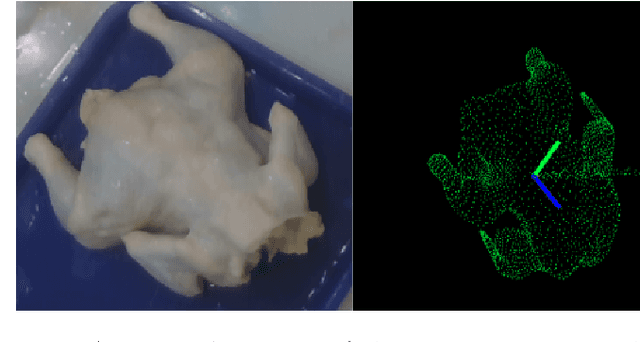Benjamin Joffe
Adapt3R: Adaptive 3D Scene Representation for Domain Transfer in Imitation Learning
Mar 06, 2025Abstract:Imitation Learning (IL) has been very effective in training robots to perform complex and diverse manipulation tasks. However, its performance declines precipitously when the observations are out of the training distribution. 3D scene representations that incorporate observations from calibrated RGBD cameras have been proposed as a way to improve generalizability of IL policies, but our evaluations in cross-embodiment and novel camera pose settings found that they show only modest improvement. To address those challenges, we propose Adaptive 3D Scene Representation (Adapt3R), a general-purpose 3D observation encoder which uses a novel architecture to synthesize data from one or more RGBD cameras into a single vector that can then be used as conditioning for arbitrary IL algorithms. The key idea is to use a pretrained 2D backbone to extract semantic information about the scene, using 3D only as a medium for localizing this semantic information with respect to the end-effector. We show that when trained end-to-end with several SOTA multi-task IL algorithms, Adapt3R maintains these algorithms' multi-task learning capacity while enabling zero-shot transfer to novel embodiments and camera poses. Furthermore, we provide a detailed suite of ablation and sensitivity experiments to elucidate the design space for point cloud observation encoders.
Canonical mapping as a general-purpose object descriptor for robotic manipulation
Mar 02, 2023Abstract:Perception is an essential part of robotic manipulation in a semi-structured environment. Traditional approaches produce a narrow task-specific prediction (e.g., object's 6D pose), that cannot be adapted to other tasks and is ill-suited for deformable objects. In this paper, we propose using canonical mapping as a near-universal and flexible object descriptor. We demonstrate that common object representations can be derived from a single pre-trained canonical mapping model, which in turn can be generated with minimal manual effort using an automated data generation and training pipeline. We perform a multi-stage experiment using two robot arms that demonstrate the robustness of the perception approach and the ways it can inform the manipulation strategy, thus serving as a powerful foundation for general-purpose robotic manipulation.
Pose estimation and bin picking for deformable products
Nov 12, 2019



Abstract:Robotic systems in manufacturing applications commonly assume known object geometry and appearance. This simplifies the task for the 3D perception algorithms and allows the manipulation to be more deterministic. However, those approaches are not easily transferable to the agricultural and food domains due to the variability and deformability of natural food. We demonstrate an approach applied to poultry products that allows picking up a whole chicken from an unordered bin using a suction cup gripper, estimating its pose using a Deep Learning approach, and placing it in a canonical orientation where it can be further processed. Our robotic system was experimentally evaluated and is able to generalize to object variations and achieves high accuracy on bin picking and pose estimation tasks in a real-world environment.
 Add to Chrome
Add to Chrome Add to Firefox
Add to Firefox Add to Edge
Add to Edge